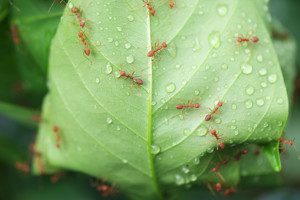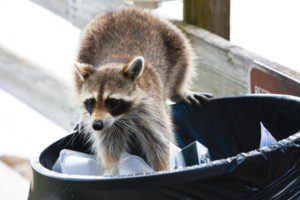The Impact of Seasons on Pest Movement and Patterns
Pests are always on the lookout for warm, safe shelter and a reliable food source. Sadly, many of the more enticing places that attract common pests happen to be our homes and businesses!
Since insect patterns and movement are heavily influenced by the seasons, the threats they may pose change as the weather shifts. In fact, even relatively simple shifts in temperature can lead to shifts in pest activity. In order to keep critters out and safeguard your home from infiltration, you should take note of how they behave under different weather conditions and take the proper precautions during each shift.

When are pests most active?
Every pest — whether it be mammal, bird, or insect — thrives under slightly different conditions. However, you will find some commonalities between these various creatures when it comes to weather. For example, most pests prefer warmer temperatures over colder. They also need ample water and nutrition. And finally, they require shelter of some sort, no matter the elements.
This sounds simple enough but knowing the best and worst weather for pests isn’t cut and dried. Shifts in temperature cause changes in behavior, and when the mercury moves to a less than ideal level for various pests, you may notice that you’ve begun to develop an insect or rodent problem. Such cases may make you consider the need for seasonal pest control.
How the weather can affect pest activities
Pests have a number of common activities in which they regularly engage, such as:
- Seeking food
- Seeking water
- Seeking to mate
- Seeking places to build nests
When conditions are ideal, they perform most of these tasks out in nature. However, if you find yourself asking, “Are bugs worse this year?”, then they may have migrated into your home or business because of:
- Hibernation and overwintering. Most people know that bugs and mammals alike don’t flourish during the winter. That’s why they hibernate or overwinter when the end of autumn draws near. Unfortunately, they may very well seek out your property if it’s close to them and easy for them to access.
- Temperature. Interestingly, pests don’t merely try to escape from cold temperatures, they also seek shelter when things get too hot. No matter if it’s warm or chilly, they will also try to shelter in your home or business if they can get inside.
Just Right Temperatures
 Ideal temperatures for pest propagation include whenever temperatures stay significantly above freezing or frost and when food and water become more abundant. In many parts of the United States, these conditions occur during the spring months when temperatures warm and the flowers bloom. With this combination of moisture and warmth pests come out of their winter nesting spots and movement and activity begin to increase. Wasps and bees will wake up from their dormant state, termites may begin to emerge and swarm and excessive amounts of rain might bring ants indoors looking for higher-ground.
Ideal temperatures for pest propagation include whenever temperatures stay significantly above freezing or frost and when food and water become more abundant. In many parts of the United States, these conditions occur during the spring months when temperatures warm and the flowers bloom. With this combination of moisture and warmth pests come out of their winter nesting spots and movement and activity begin to increase. Wasps and bees will wake up from their dormant state, termites may begin to emerge and swarm and excessive amounts of rain might bring ants indoors looking for higher-ground.
Spring not only brings warmer weather, but also increased mating activity for pests. While you may see more pests overall in the springtime, most of them will actually stay outdoors as they search for food and water sources or mates. Some species of pests though will want to take shelter inside protected areas like your home to build their nests. You should be mindful of any changes you notice inside your home, such as a pile of bug wings, droppings, or ant invasion. If you remain aware of regular insect travel and patterns in and around your home every spring season, you will inevitably be better positioned to notice atypical pest behavior and note your observations to a pest control professional.
Similarly, summer serves as an ideal time for pests due to more than adequate temperatures. Ironically, humans typically see a reprieve from insects and pests seeking shelter in structures because food, water, and mates are plentiful outside! That doesn’t mean you’ll entirely avoid irritants, though. Increases in the number of mosquitoes often result from heavy spring and summer rains, as water sources are a common breeding site. Although mosquitoes won’t try to invade your home, mosquito bites and general presence are a nuisance when trying to enjoy your yard in the summer months.
Other common summertime insects include ticks, bees and wasps. Bees and wasps may build their homes in any opening of your house, beneath overhangs or in the ground near the foundation of your home. Just like ticks and mosquitos, bees and wasps are annoying and present health risks when they attack humans. Trying to make sure that you deter bees and wasps from building their homes near you and establishing a presence in your yard requires effort but can certainly increase the enjoyment of your outdoor space as temperatures rise.
Hot Temperatures
As we mentioned previously, hot temperatures can have just as deleterious an effect on pests as colder weather. However, asking what month bugs go away is a difficult question to answer. Many homeowners and business managers find that warmer temperatures mean fewer pests in their property. However, as it grows hotter, pests find that they cannot tolerate the outdoor environment and may try to shelter where you live and work.
Cold Temperatures
 Something similar occurs as it begins to grow colder. As the temperature drops, pests and insects will begin to prepare and many species will seek out a warm, sheltered place. As a result, you might begin to see an increase of spiders, boxelder bugs, or lady bugs entering your home. For the most part, however, these pests tend to stay out of sight, hidden in the cracks and crevices of your home.
Something similar occurs as it begins to grow colder. As the temperature drops, pests and insects will begin to prepare and many species will seek out a warm, sheltered place. As a result, you might begin to see an increase of spiders, boxelder bugs, or lady bugs entering your home. For the most part, however, these pests tend to stay out of sight, hidden in the cracks and crevices of your home.
Additionally, you should pay attention to the effect moisture and dryness have upon pests. In unseasonably warm weather that also features plenty of precipitation, they main remain outdoors. However, during dryer times, they could very well seek out property, particularly if you have active leaks.
Larger pests, however, may be searching for an entry point into your home. Therefore, this is an important time to make sure that any cracks, crevices, holes and gaps in your foundation, siding, garage, floors, and attic are sealed properly to keep pests out. It is also important to check your roof materials as strong winds can crack shingles and siding materials and create openings for pests to sneak into your home. By conducting proper home maintenance in the fall you can reduce the chances of rats and mice entering your house in the winter months.
For many insects, colder temperatures indicate that it’s about time to find suitable shelter. Some insects will hibernate as a way to save energy and avoid inhospitable climates. Others may migrate to warmer weather or outlast colder periods in their nymph, egg or larvae stages in the ground or water. Bees and wasps tend to seek shelter within logs, trees or in the eaves of homes, whereas ants will retreat to their nests. Many of these insects survive by establishing a safe place to outlast the weather outdoors, safe from the elements.
Other pests, such as mice and rats, are not as tolerant of the winter months and may come looking for a safe retreat inside your home. Therefore, it is extremely important to protect your home from potential pests by taking the proper precautions in the fall months to defend your home.
When you are attentive to seasonal insect and pest shifts you can be better prepared to deter any unwelcome visitors from entering your home. However, you’re not always in complete control to deter insects and pests from seeking shelter in your home and do-it-yourself efforts to combat a problem are not always safe or advised. To ensure you properly address any warning signs of an infestation or inhabitation it is best to contact your local pest control experts.